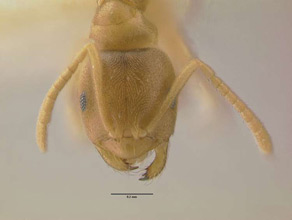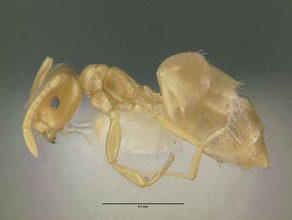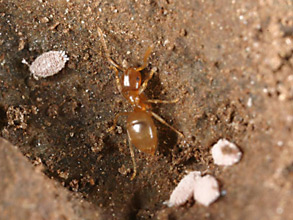- Identification
- Very small yellow ants. Their color distinguishes this species from other named North American Brachymyrmex, which vary from grey to dark brown. The genus can be readily separated from other Formicinae by the combination of their small size and 9 segmented antenna.
- Biology
- Brachymyrmex depilis are opportunistic nesters, making galleries in downed wood, at the base of living vegetation, under bark, under stones, in litter, along roots and in the soil. Their small size and thin integument means individuals desiccate quickly, leading colonies to settle in places where they can have humid nest chambers.
- additional biology notes...
- Distribution
- Range
- United States, S Canada, Mexico. Most U.S. states and south into Mexico. This species is putatively wide ranging. A badly needed taxonomic revision of the North America forms will likely reveal that Brachymyrmex depilis is a number of distinctive species.
- Navajo Reservation Records
- Records being processed.
- Additional Notes
- In addition to being general scavengers workers also tend root aphids and coccids in underground galleries. The gastral tergites of Brachymyrmex depilis workers have flexible connections that permit their gaster to easily expand and contract. Their crops can be filled with a large amount of liquid, at least relative to the overall size of a worker.
- Etymology
- Descriptive. depilis = "without hair"

- Literature
- Carter, W. G. 1962. Ant distribution in North Carolina. Journal of the Elisha Mitchell Scientific Society. 78:150-204.
- Cole, A. C., Jr. 1940. A guide to the ants of the Great Smoky Mountains National Park, Tennessee. American Midland Naturalist. 24:1-88.
- Creighton, W. S. 1950. The ants of North America. Bulletin of the Museum of Comparative Zoology at Harvard University. 104:1-585.
- Emery, C. 1893. Beiträge zur Kenntniss der nordamerikanischen Ameisenfauna. Zoologische Jahrbücher, Abteilung für Systematik, Geographie und Biologie der Tiere. 7:633-682. PDF
- Van Pelt, A. F. 1958. The ecology of the ants of the Welaka Reserve, Florida (Hymenoptera: Formicidae). Part II. Annotated list. American Midland Naturalist. 59:1-57.
- A note about these publications. The literature cited here is not meant to be an exhaustive list of papers published about this species.
Page authored by David Lubertazzi and Gary Alpert



